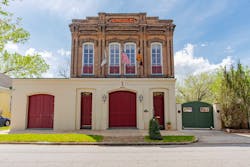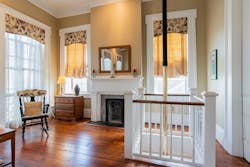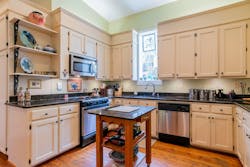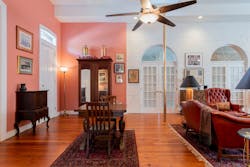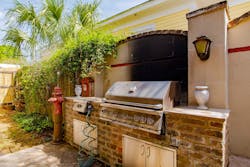For Sale: Three-Bedroom, 151-Year-Old Former AL Fire Station
Over nearly three decades, Tilmon and Jamie Brown have become accustomed to strangers knocking on, and even trying to open, their front door in downtown Mobile. And you can’t really blame visitors for trying to get into the place that looks like it could be a restaurant, or possibly a museum that might be open for tours, with a historical marker out front and the word “Creole” etched in the brick above the upstairs windows.
While it was originally built as a fire station, it’s been the Browns’ family home since the mid-1990s. Now that the couple are empty-nesters, they’ve decided to try to sell their beloved, unusual home.
Downtown Mobile was “a wasteland,” Tilmon says, when he started looking at properties there. He found an abandoned, two-story brick building with a collapsed roof that intrigued him. “There’s no way to describe the condition,” he says. Still, he bought it, sight-unseen, at a courthouse sale.
Designed by Mobile architect James H. Hutchisson and built in 1869, the building on North Dearborn Street originally served as the Creole Fire Station No. 1. The fire station became a cultural center for the Creole community, as the historical marker explains. Some 200 weddings were held there, and it’s where the Excelsior Band – a staple of Mobile Mardi Gras parades – originated.
The arched central bay is where the firefighters would board a horse-drawn fire truck. The horses were kept in a stable to one side. Upstairs, four firefighters were on duty 24 hours a day, seven days a week. They slept in their barracks, ready to slide down the fire pole and harness the horses when the bell rang signaling a fire.
“I wanted to maintain its integrity as a fire station but didn’t want to go over the top,” Tilmon says. “I tried to tastefully keep it a fire station without changing much. It came out really, really nice.”
The original brass firepole was missing, but Tilmon found another one of the same era in Canada. “There’s rarely a male who visits who doesn’t want to slide down that pole,” he says. More often, he and Jamie use it as a laundry chute.
A semi-retired general contractor and developer, Tilmon has incorporated several other architectural salvage finds into the back patio, such as cast-iron columns that once stood in Bienville Square, bricks from the O’Gwynn Building at Conti and Conception streets, and marble from the old post office on St. Joseph Street.
The Creole Fire Company, the first volunteer fire company in the state of Alabama, operated until the turn of the century, when the city took over the privately operated fire departments. The fire station was in operation until the mid-1920s.
The building was vacant for a while, until it was purchased by the 7-Up Bottling Company. Later, it was an upholstery shop servicing “Automobile Alley” on nearby St. Louis Street. Then it was abandoned for the next 30 years or so, until it caught Tilmon’s eye.
The Browns have enjoyed watching downtown Mobile grow and change dramatically in the years they’ve lived in the former fire station. Cathedral Square didn’t exist when they moved there. They never had to go to Mardi Gras parades, Tilmon jokes; Mardi Gras came to them. “We could sit here and hear the drums beating, then walk to the parade three minutes before it came by,” he says.
He and Jamie have purchased land in Silverhill, where they are building a new home. Tilmon says he intends to become a “gentleman farmer.”
They know they’ll miss their one-of-a-kind home in the heart of downtown Mobile, though. “It has been a joy to live in such a unique place,” Tilmon says. “It’s time to move on and let another family enjoy what we’ve enjoyed.”
———
©2020 Alabama Media Group, Birmingham
Visit Alabama Media Group, Birmingham at www.al.com
Distributed by Tribune Content Agency, LLC.
